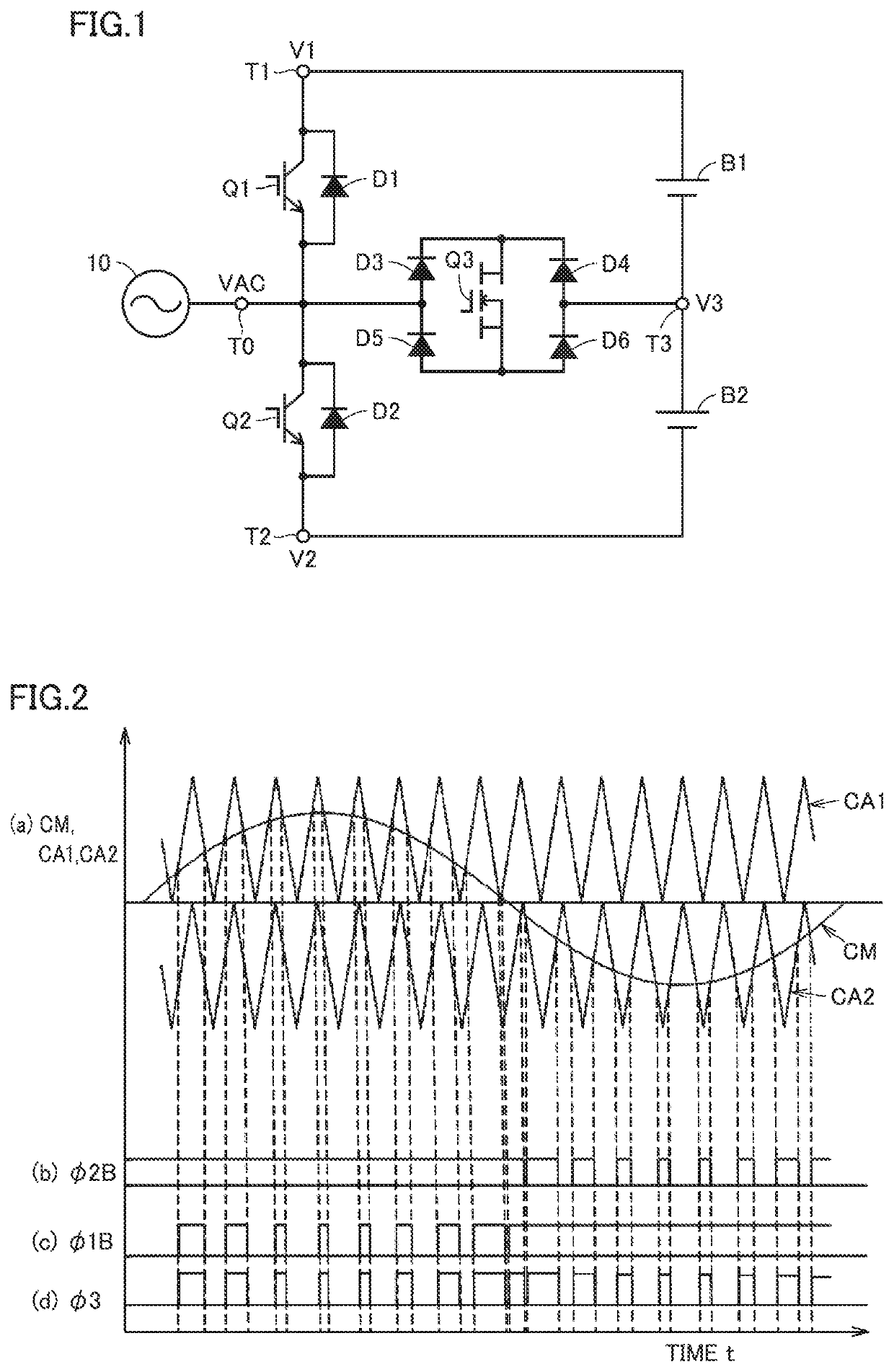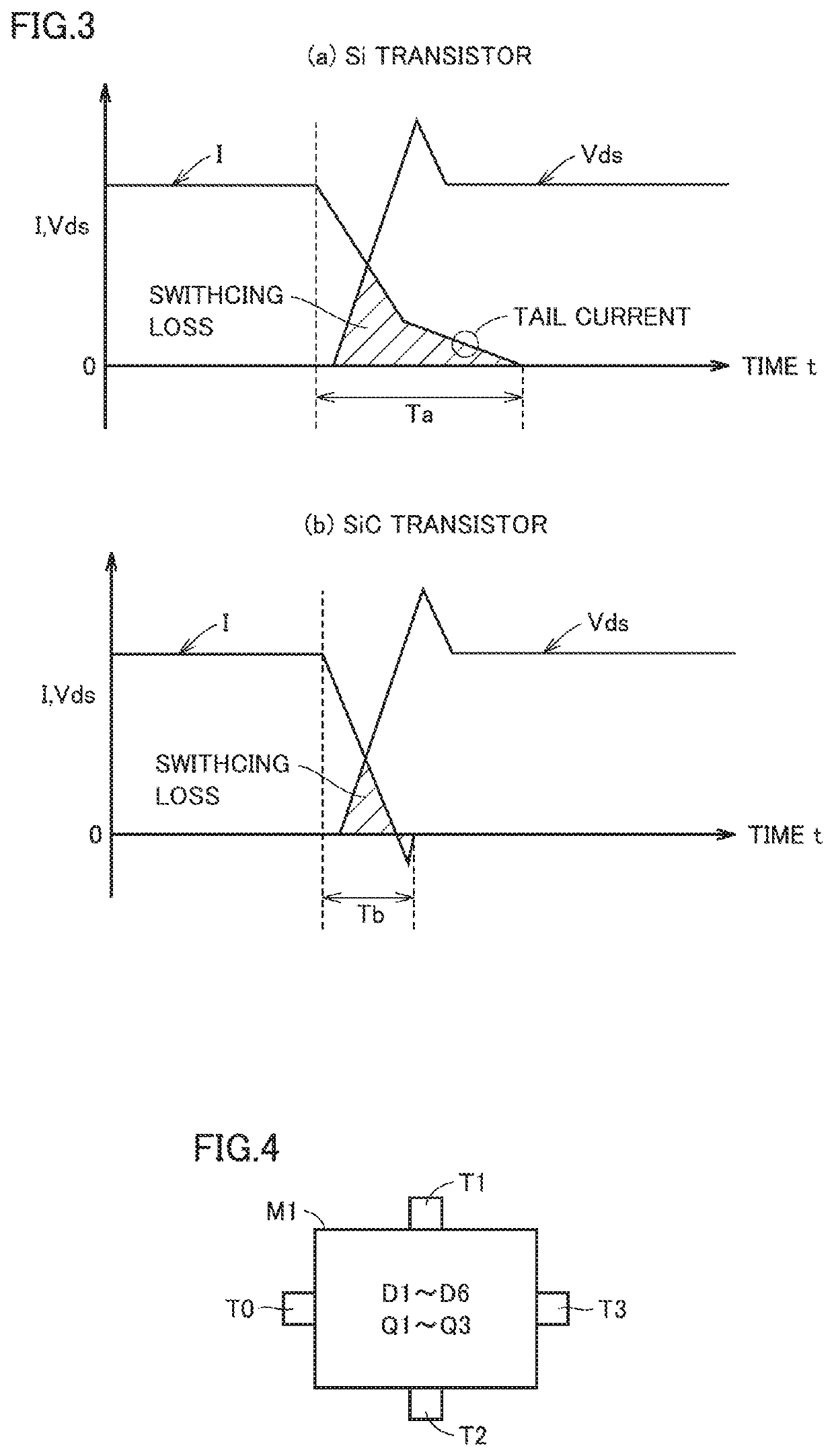Converter and power conversion device using same
a technology of converter and power conversion device, which is applied in the direction of efficient power electronics conversion, emergency power supply arrangement, climate sustainability, etc., can solve the problems of reducing the cost of the converter, reduce the size and cost of the device, reduce the loss of switching and recovery, and reduce the cost
- Summary
- Abstract
- Description
- Claims
- Application Information
AI Technical Summary
Benefits of technology
Problems solved by technology
Method used
Image
Examples
embodiment 1
[0023]FIG. 1 is a circuit diagram showing a configuration of a converter according to Embodiment 1 of the present invention. With reference to FIG. 1, this converter includes an input terminal T0, output terminals T1 to T3 (first to third output terminals), diodes D1 to D6 (first to sixth diodes), and transistors Q1 to Q3 (first to third transistors).
[0024]Input terminal T0 receives an AC voltage VAC of a commercial frequency from, for example, a commercial AC power supply 10. Output terminals T1 and T3 are connected respectively with the positive electrode and negative electrode of a battery B1. Output terminals T3 and T2 are connected respectively with the positive electrode and negative electrode of a battery B2. Each of batteries B1 and B2 stores DC power. Batteries B1 and B2 are charged with DC voltages having the same value.
[0025]When the voltages at output terminals T1, T2, and T3 are respectively DC voltages V1, V2, and V3, V1>V3>V2, and V3=(V1+V2) / 2. This converter converts...
embodiment 2
[0077]FIG. 6 is a circuit block diagram showing a configuration of inverter 3 of an uninterruptible power system according to Embodiment 2 of the present invention. The general arrangement of the uninterruptible power system is as shown in FIG. 5. Converter 2 of the uninterruptible power system is the converter shown in FIG. 1. With reference to FIG. 6, inverter 3 includes input terminals T11 to T13 (first to third output terminals), an output terminal T14 (fourth output terminal), transistors Q11 to Q14 (fourth to seventh transistors), and diodes D11 to D14 (seventh to tenth diodes).
[0078]Input terminals T11 to T13 are connected respectively to DC positive bus L1, DC negative bus L2, and DC neutral point bus L3 of FIG. 5. Input terminals T11 and T13 are connected respectively with the positive electrode and negative electrode of battery B1. Input terminals T13 and T12 are connected respectively with the positive electrode and negative electrode of battery B2. Each of batteries B1 a...
embodiment 3
[0112]FIG. 11 is a circuit diagram showing a configuration of an inverter of an uninterruptible power system according to Embodiment 3 of the present invention, which is compared with FIG. 6. With reference to FIG. 11, this inverter differs from inverter 3 of FIG. 6 in that the parallel connection structure of transistor Q13 and diode D13 and the parallel connection structure of transistor Q14 and diode D14 are replaced. Transistors Q13 and Q14 have emitters connected to each other and collectors connected respectively to input terminal T13 and output terminal T14. Transistors Q11 to Q14 are controlled respectively by PWM signals φ11 to φ14. When DC voltages V1 and V3 are alternately output to output terminal T14, transistor Q14 is turned on and transistors Q11 and Q13 are alternately turned on. When DC voltages V2 and V3 are alternately output to output terminal T14, transistor Q13 is turned on and transistors Q12 and Q14 are alternately turned on.
[0113]Since the other configuratio...
PUM
| Property | Measurement | Unit |
|---|---|---|
| DC voltages | aaaaa | aaaaa |
| rated current | aaaaa | aaaaa |
| rated current | aaaaa | aaaaa |
Abstract
Description
Claims
Application Information
 Login to View More
Login to View More - R&D
- Intellectual Property
- Life Sciences
- Materials
- Tech Scout
- Unparalleled Data Quality
- Higher Quality Content
- 60% Fewer Hallucinations
Browse by: Latest US Patents, China's latest patents, Technical Efficacy Thesaurus, Application Domain, Technology Topic, Popular Technical Reports.
© 2025 PatSnap. All rights reserved.Legal|Privacy policy|Modern Slavery Act Transparency Statement|Sitemap|About US| Contact US: help@patsnap.com



